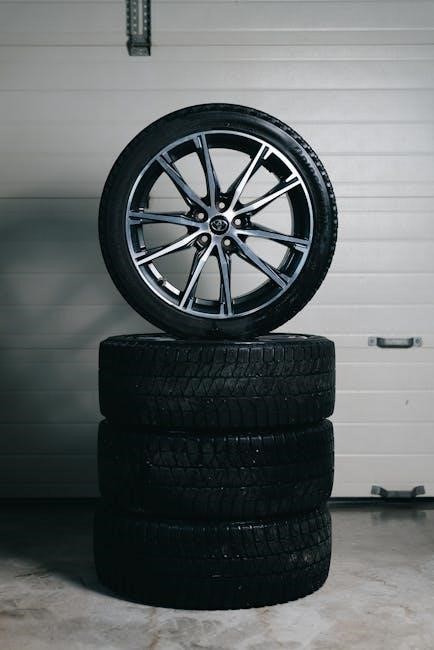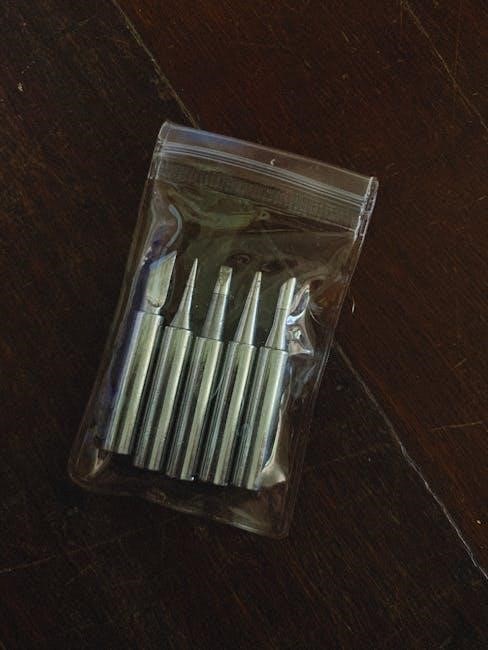Manual transmission replacement involves removing and installing a new gearbox, requiring specialized tools and expertise. This process ensures proper gear function, improves performance, and extends vehicle lifespan.
1.1 Understanding the Importance of Manual Transmission
Manual transmissions are crucial for vehicle performance, offering durability, fuel efficiency, and driver control. They are often preferred for their simplicity and lower maintenance costs compared to automatics. Manual transmissions provide better fuel economy, especially in city driving, and are ideal for drivers who enjoy precise gear control. Their mechanical efficiency makes them less prone to overheating and failure under heavy loads. Additionally, manual transmissions are cost-effective, as they typically require less expensive repairs and replacements. For enthusiasts, they offer a more engaging driving experience, fostering a connection between the driver and the vehicle. Understanding their importance helps in making informed decisions about repairs, replacements, and overall vehicle maintenance. This knowledge is essential for anyone considering manual replacement or seeking to optimize their vehicle’s performance and longevity.
1.2 Brief History of Manual Transmissions
The history of manual transmissions dates back to the early 20th century, evolving from basic gear systems to sophisticated designs. Initially, manual transmissions were simple, with fewer gears and limited functionality. Over time, advancements in engineering led to the development of synchronized gearboxes, reducing wear and improving shifting smoothness. By the mid-20th century, manual transmissions became standard in many vehicles, offering better fuel efficiency and driver control. The 1980s and 1990s saw the rise of high-performance manual transmissions, particularly in motorsports, with innovations like close-ratio gearing and lightweight materials. Today, manual transmissions remain popular for their durability, cost-effectiveness, and driving engagement. Despite the rise of automatics, manuals continue to be refined, with modern designs incorporating advanced technologies for improved performance and reliability. This rich history underscores the enduring relevance of manual transmissions in the automotive world.
1.3 Purpose of Manual Replacement
The primary purpose of manual transmission replacement is to address faulty or worn-out components that hinder vehicle performance. Over time, gears, bearings, and seals can degrade, leading to issues like slipping, noise, or fluid leaks. Replacing the transmission ensures smooth gear engagement, optimal power delivery, and improved safety. Additionally, replacement may be necessary for upgrading to a high-performance transmission, enhancing acceleration and handling. It also prevents further damage to connected systems, such as the engine and drivetrain. Whether due to wear, damage, or performance upgrades, manual replacement restores the vehicle’s functionality and reliability, ensuring a seamless driving experience. This process is crucial for maintaining the vehicle’s overall health and longevity, making it a vital procedure for drivers who value control and efficiency behind the wheel.

Tools and Equipment Needed for Manual Replacement
Essential tools include socket sets, wrenches, and jack stands. Safety equipment like gloves and goggles is crucial. Specialized tools such as bearing pullers and seal installers may be required for the job.
2.1 Essential Tools for the Job
The essential tools for manual transmission replacement include a socket set, wrenches, pliers, screwdrivers, and a jack with jack stands. A transmission jack or cherry picker is crucial for safely handling the gearbox. Specialized tools like bearing pullers and seal installers may be necessary for disassembly and reassembly. A set of punches and chisels can help with removing retaining pins and other components. Additionally, a torque wrench is essential for proper bolt tightening. Ensure all tools are in good condition to avoid rounding bolts or damaging parts. A transmission repair manual specific to your vehicle model is also vital for guidance. Proper tools ensure efficiency and prevent costly mistakes during the replacement process.

2.2 Safety Equipment and Precautions
When performing a manual transmission replacement, safety is paramount. Essential safety equipment includes steel-toe boots, gloves, safety glasses, and a face mask to protect against falling tools, sharp edges, and debris. Ensure the vehicle is securely supported with jack stands on a level surface to prevent it from falling. Never work under an unsupported vehicle, as this can lead to severe injury or death. Proper ventilation is crucial to avoid inhaling harmful fumes from cleaning agents or lubricants. Disconnect the battery to prevent electrical hazards and be cautious of hot components, such as the engine or exhaust system, which can cause burns. Always follow proper lifting techniques to avoid strain or injury. By adhering to these precautions, you can minimize risks and ensure a safe working environment throughout the replacement process.
2.3 Workspace Preparation
Proper workspace preparation is critical for a successful manual transmission replacement. Start by choosing a clean, well-ventilated, and flat surface to ensure stability and safety. Cover the floor with drop cloths or plastic sheets to protect against spills and debris. Gather all necessary tools and equipment, as outlined in section 2.1, and organize them within easy reach. Ensure proper lighting, such as a LED work light, to illuminate the underside of the vehicle. A drain pan is essential for catching transmission fluid during removal. Raise the vehicle using a hydraulic lift or jack stands, ensuring it is securely supported. Keep safety equipment, such as gloves and safety glasses, readily available. Finally, label and organize removed parts to avoid confusion during reassembly. A well-prepared workspace minimizes delays and reduces the risk of errors or accidents during the replacement process.

Understanding Manual Transmissions

Manual transmissions consist of gears, shafts, and bearings, enabling drivers to control gear shifts for better fuel efficiency and performance. They are categorized into types like H-pattern and sequential.
3.1 Components of a Manual Transmission
A manual transmission consists of several key components, including gears, shafts, and bearings. The input shaft connects to the clutch, while the output shaft links to the driveshaft. Gears are mounted on these shafts, allowing for manual shifting. The transmission case houses all internal parts, protecting them from damage. Bearings reduce friction between moving components, ensuring smooth operation. The gearshift and linkage system enables the driver to engage different gears. Additionally, synchronizers facilitate smooth gear transitions by equalizing speed between the gear and shaft. These components work together to transfer power from the engine to the wheels, enabling manual control over gear selection for optimal performance and efficiency.
3.2 How Manual Transmissions Work
A manual transmission operates by transferring power from the engine to the wheels through a series of gears. The driver uses the clutch pedal to disconnect the engine from the transmission, allowing gear shifts. Pressing the clutch engages the gearshift, which selects the desired gear. Releasing the clutch slowly reconnects the engine to the transmission, enabling power transfer. The transmission uses bearings to reduce friction and synchronizers to align gear speeds, ensuring smooth transitions. As the driver shifts gears, the input shaft rotates, engaging different gear ratios on the output shaft. This system provides precise control over speed and torque, making manual transmissions popular for their performance and efficiency. Proper timing and driver input are essential for seamless operation, ensuring optimal power delivery and vehicle responsiveness.
3.3 Types of Manual Transmissions
Manual transmissions come in various types, each designed for specific applications. The most common is the standard manual transmission, found in everyday vehicles, offering simplicity and efficiency. High-performance manual transmissions are built for durability and speed, often featuring reinforced components and close-ratio gearing. Racing transmissions are lightweight and optimized for high RPMs, with advanced materials like carbon fiber. Sequential manual transmissions, commonly used in motorsports, eliminate the need for a clutch pedal, allowing faster shifts. Each type is tailored to its use case, whether for daily driving, performance, or competition. Understanding these differences helps in selecting the right transmission for a vehicle, ensuring optimal performance and reliability. Proper maintenance and repair are essential to extend their lifespan and maintain functionality.

The Manual Replacement Process
The manual replacement process involves preparing the vehicle, disconnecting components, removing the old transmission, installing the new one, reconnecting parts, and performing post-installation checks for optimal functionality.
4.1 Preparing the Vehicle and Workspace
Preparing the vehicle and workspace is crucial for a smooth manual transmission replacement. Start by securing the car on level ground using jack stands and ensure the parking brake is engaged. Disconnect the battery to prevent electrical issues. Next, gather all necessary tools and equipment, such as wrenches, sockets, and transmission jacks. Drain the transmission fluid and cover the workspace with protective materials to avoid damage from spills. Remove any components that obstruct access to the transmission, such as the driveshaft or exhaust system. Clean the area around the transmission to ensure visibility and prevent contamination. Finally, consult a repair manual specific to your vehicle to familiarize yourself with the process. A well-prepared workspace and vehicle significantly reduce the risk of complications during the replacement process.
4.2 Disconnecting Components
Disconnecting components is a critical step in manual transmission replacement. Begin by disconnecting the battery to prevent electrical hazards. Next, remove the driveshaft to access the transmission. Use a wrench to loosen the bolts securing the driveshaft and carefully pull it out. Then, disconnect the exhaust system to gain better access to the transmission area. Remove any electrical connectors attached to the transmission, such as sensors or solenoids, and label them for easy reconnection later. Additionally, disconnect the clutch slave cylinder and the gear shifter linkage to free the transmission from the vehicle. Use a transmission jack to support the transmission during disconnection. Ensure all components are safely removed and stored to avoid damage. Properly disconnecting these components ensures a smoother removal and installation process.
4.3 Removing the Old Transmission
Removing the old transmission requires careful planning and execution. Start by using a transmission jack to support the unit, ensuring it is securely fastened. Next, remove the crossmember and any additional components holding the transmission in place. Gently rock the transmission back and forth while pulling it away from the engine to dislodge it from the bellhousing. Be cautious, as transmissions are heavy and can cause injury or damage if mishandled. Once the transmission is free, carefully lower it to the ground using the jack. Inspect the area to ensure no parts remain connected. Finally, move the old transmission to a safe location for disassembly or disposal. Proper removal ensures a clean and efficient installation of the new transmission.
4.4 Installing the New Transmission
Installing the new transmission begins with aligning it properly with the engine. Use a transmission jack to lift and maneuver the unit into place, ensuring it fits snugly into the bellhousing. Secure the transmission using the provided mounting hardware, tightening bolts in a star pattern to avoid warping the case. Reconnect the driveshaft, clutch system, and any electrical connectors, ensuring all components are tightly fastened. Refill the transmission fluid according to the manufacturer’s specifications. Finally, test the system by shifting through all gears to ensure smooth operation and check for any leaks or unusual noises. Proper installation is critical for optimal performance and longevity of the transmission.

4.5 Reconnecting Components
Reconnecting components is a critical step in the manual transmission replacement process. Begin by reconnecting the driveshaft to the transmission, ensuring it is securely fastened with the correct hardware. Next, reattach the clutch system, including the release bearing and fork, making sure they are properly aligned and adjusted. Electrical connectors for sensors and solenoids should be reconnected carefully to avoid damage. Gear linkages and shifters must also be reinstalled, ensuring they move smoothly and engage gears correctly. Use a torque wrench to tighten all bolts to the manufacturer’s specifications. Finally, double-check all connections for tightness and proper alignment. Testing the vehicle after reconnection is essential to confirm that all components function as intended and that there are no issues with gear engagement or fluid leaks.
4.6 Post-Installation Checks
After installing the new manual transmission, perform a series of checks to ensure everything functions correctly. Start by inspecting for any fluid leaks around the transmission pan, cooler lines, and seals. Check the gearshift linkage to confirm smooth and precise gear engagement. Test the clutch pedal to ensure it operates properly, with a firm bite point. Next, take the vehicle for a test drive, shifting through all gears to verify smooth operation and absence of unusual noises or vibrations. Pay attention to any signs of misalignment or improper installation, such as difficulty engaging gears or abnormal sounds. Finally, recheck all bolts and connections to ensure they are tightened to the manufacturer’s specifications; Address any issues promptly to prevent further complications and ensure optimal performance.

Costs and Factors Influencing Manual Replacement
Manual transmission replacement costs range from $1,000 to $3,000, depending on labor, location, and parts. DIY savings are significant, but professional expertise ensures reliability and warranty coverage.
5;1 Estimated Cost of Manual Replacement
The estimated cost for manual transmission replacement typically ranges from $1,000 to $3,000, depending on the vehicle and location. This includes parts and labor, with transmission units costing between $500 and $1,500. Labor costs vary widely, often between $500 and $1,200, depending on the mechanic’s rates and the complexity of the job. Additional expenses may arise for related repairs, such as clutch replacement or fluid changes. DIY replacement can save on labor costs, with parts alone costing $500 to $1,500. However, professional installation ensures warranty coverage and reliability. Urban areas often have higher labor costs compared to rural regions. Overall, the total expense reflects the transmission’s quality, the vehicle’s make, and the technician’s expertise.
5.2 Factors Affecting the Cost
The cost of manual transmission replacement is influenced by several factors, including the type and quality of the transmission, labor rates, and the vehicle’s make and model. High-performance or specialized transmissions, such as those used in racing, can significantly increase expenses. Labor costs vary depending on the mechanic’s expertise and the shop’s location, with urban areas typically charging more. Additional repairs, like clutch replacement or bearing upgrades, can also add to the total cost. Furthermore, the availability of parts and any custom modifications can impact the final price. DIY projects may reduce labor costs but require purchasing tools and parts, while professional services offer warranties and assurance of quality workmanship. These variables make it essential to consult with a specialist for an accurate estimate tailored to the vehicle’s needs.
5.3 DIY vs. Professional Replacement
Deciding between DIY and professional manual transmission replacement depends on expertise, time, and budget. DIY projects can save money but require mechanical knowledge, specialized tools, and a clean workspace. Professionals offer expertise, ensuring proper installation and warranty coverage, but at a higher cost. DIY suits confident individuals with experience, while professionals are recommended for complex cases or those unsure of their skills. Balancing cost, convenience, and reliability is key to making the right choice for your vehicle’s needs.

Maintenance and Troubleshooting
Regular fluid checks, gear inspections, and timely repairs prevent major issues. Addressing worn components and leaks early ensures smooth operation and extends transmission lifespan.
6.1 Regular Maintenance Tips
Regular maintenance is crucial for extending the life of a manual transmission. Check transmission fluid levels monthly and top up as needed. Inspect for leaks around seals and gaskets. Replace the transmission filter every 30,000 to 60,000 miles to ensure clean fluid circulation. Lubricate gear components periodically to prevent wear. Avoid extreme temperatures and rough driving habits, as they can strain the transmission. Monitor gear engagement smoothness and address any grinding or slipping promptly. Regularly inspect the clutch and pressure plate for wear. Keep the transmission mounts secure to prevent misalignment. Flush and replace transmission fluid every 50,000 to 100,000 miles, depending on usage. These steps help maintain optimal performance and prevent costly repairs.
6.2 Common Issues and Solutions
Common issues with manual transmissions include gear grinding, slipping, or difficulty shifting. These problems often stem from worn synchronizers, damaged gear teeth, or low transmission fluid levels. Strange noises, such as clunking or whining, can indicate faulty bearings or shafts. Leaks around seals or gaskets may lead to fluid loss, causing poor engagement. Solutions involve inspecting and replacing worn components, replenishing fluid, and tightening loose connections. For persistent issues, rebuilding or replacing the transmission may be necessary. Regular inspections and prompt repairs can prevent minor problems from escalating into major failures. Addressing these issues early ensures smooth operation and extends the transmission’s lifespan. Always refer to a repair manual or consult a professional for complex diagnoses and repairs.

Additional Considerations
Consider transmission rebuild vs. replacement, upgrading to high-performance options, and future trends like electric vehicles. Evaluate cost, expertise, and compatibility when making informed decisions for your vehicle’s needs.
7.1 Transmission Rebuild vs. Replacement
A transmission rebuild involves disassembling, inspecting, and replacing worn or damaged parts, then reassembling the unit. This option is cost-effective for minor issues and maintains original functionality. Replacement, however, involves installing a new or refurbished transmission, often recommended for severe damage. Costs vary based on labor, parts, and transmission type. Rebuilds are typically cheaper but require more time and expertise. Replacement offers a quicker solution with a warranty. Consider vehicle age, extent of damage, and budget when deciding. Experts suggest evaluating clutch performance and flushing systems before committing. Proper diagnosis ensures the best choice for long-term reliability and performance.
7.2 Upgrading to a High-Performance Transmission
Upgrading to a high-performance transmission enhances your vehicle’s acceleration, durability, and overall driving experience. This process involves installing a transmission designed for increased power handling, smoother shifting, and improved torque capacity. High-performance transmissions often feature strengthened gears, bearings, and advanced cooling systems. They are ideal for racing, heavy-duty towing, or high-performance driving. When upgrading, consider factors like compatibility with your vehicle’s engine and drivetrain. Expert technicians can guide you through the selection and installation process. Additionally, upgrading may require modifications to the clutch and shifter for optimal performance. While the cost is higher than a standard replacement, the benefits for enthusiasts and heavy users make it a worthwhile investment. Proper installation ensures reliability and maximizes the transmission’s potential.
7.3 Future Trends in Manual Transmissions
Future trends in manual transmissions are evolving to meet the demands of modern vehicles and driver preferences. One emerging trend is the integration of manual transmissions with hybrid and electric powertrains, offering improved fuel efficiency without sacrificing driver engagement. Additionally, advancements in materials and design are leading to lighter, more durable transmissions with enhanced gear ratios for better performance. Technology like automated manual transmissions (AMTs) is also gaining traction, combining the efficiency of manuals with the convenience of automatics. Furthermore, high-performance transmissions are being developed for motorsports and enthusiast vehicles, featuring advanced cooling systems and reinforced components. As vehicles become more sophisticated, manual transmissions are adapting to remain relevant, blending tradition with innovation to cater to both everyday drivers and performance enthusiasts.
Manual transmission replacement is a complex yet rewarding process that requires careful planning, specialized tools, and a deep understanding of automotive mechanics. Whether you choose to tackle the job yourself or seek professional help, the end result is a vehicle that performs better, runs more efficiently, and lasts longer. By following the steps outlined in this guide, you can ensure a successful replacement, avoiding common pitfalls and costly mistakes. Remember, regular maintenance and prompt repairs are key to extending the life of your manual transmission. With the right knowledge and skills, you can keep your vehicle in top condition, enjoying the unique driving experience that only a manual transmission can provide. Always prioritize safety, precision, and quality when working on your vehicle’s transmission system.




